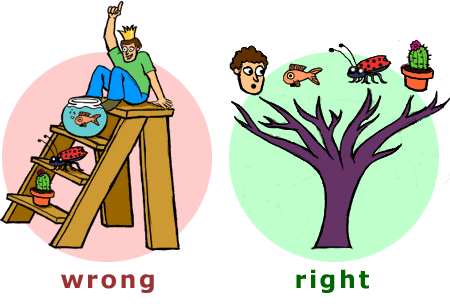Misinterpretations and intuitive ideas about evolutionary trees
by the Understanding Evolution team
Research shows that many students, teachers, and members of the general public misinterpret trees in predictable ways. Such misinterpretations are commonly known as ‘misconceptions’; however, many of these “wrong” ideas are actually perfectly sound ways of reasoning that learners simply apply in the wrong situation or in the wrong way. In other words, common explanations (such as change resulting from intentional choices) work perfectly well for many everyday situations, but these explanations are not helpful for thinking about evolutionary change. While the term ‘misconception’ is a familiar way to describe such ideas, they are more accurately thought of as “intuitive” or “everyday” interpretations.
Reviewing the intuitive conceptions, gleaned from the research literature, can help you anticipate ways that learners are likely to misinterpret evolutionary trees. Though it might be tempting to try to root out such conceptions and “replace” them with correct ones, this approach is unlikely to be effective and fails to recognize the useful roles that these ways of reasoning may play in other contexts. Instead, here are a few general tips for designing instructional experiences to help students build on their intuitive conceptions:
- Encourage learners to recognize phylogenies as a specialized representational form that requires setting aside everyday ways of reasoning
- Encourage learners to reflect on their explanations (i.e., engage in metacognition) and be explicit about their intuitive approaches to phylogenies
- Help learners recognize why they use these intuitive ways of reasoning (because they are useful in many other situations!) and compare such intuitive approaches with scientifically acceptable ones
- Engage learners with instruction that acknowledges students’ intuitive conceptions about phylogenies, directly refutes them, and introduces scientific interpretations as viable alternatives
- Help learners see the similarities between trees that they are able to interpret correctly and trees for which their intuitive conceptions lead them astray
In order to build on students’ intuitive conceptions, you’ll need to know what they are. Here, you can review common misinterpretations documented by research:
- Review misinterpretations and intuitive ideas about evolutionary ‘progress’ or ‘advancement’
- Review misinterpretations and intuitive ideas about relatedness
- Review misinterpretations and intuitive ideas about time
- Review misinterpretations and intuitive ideas about evolutionary change
Design phylogenies that discourage misinterpretations — visit Tips for tree design.
Feeling lost? Review tree basics with the primer.

